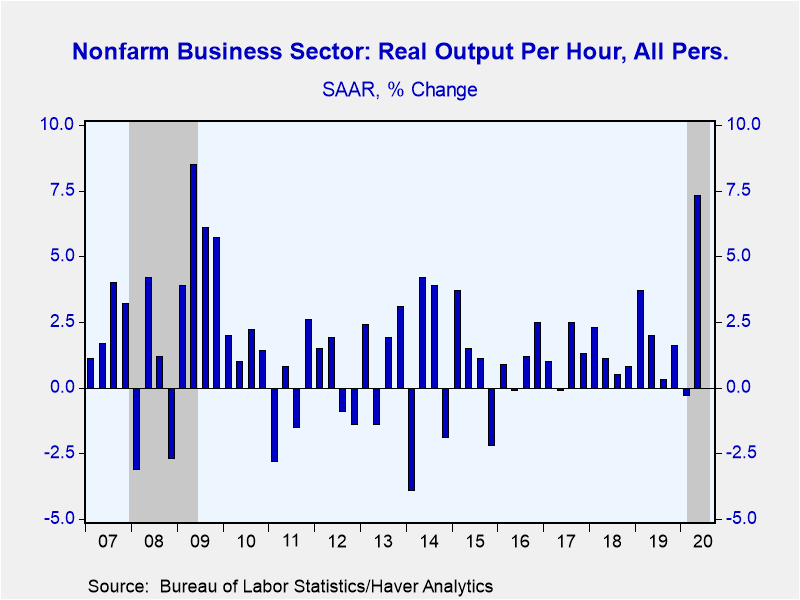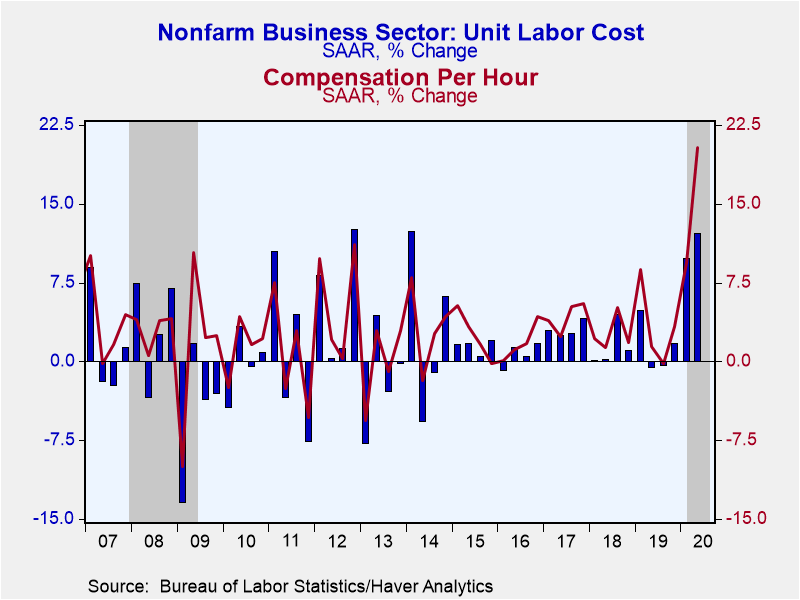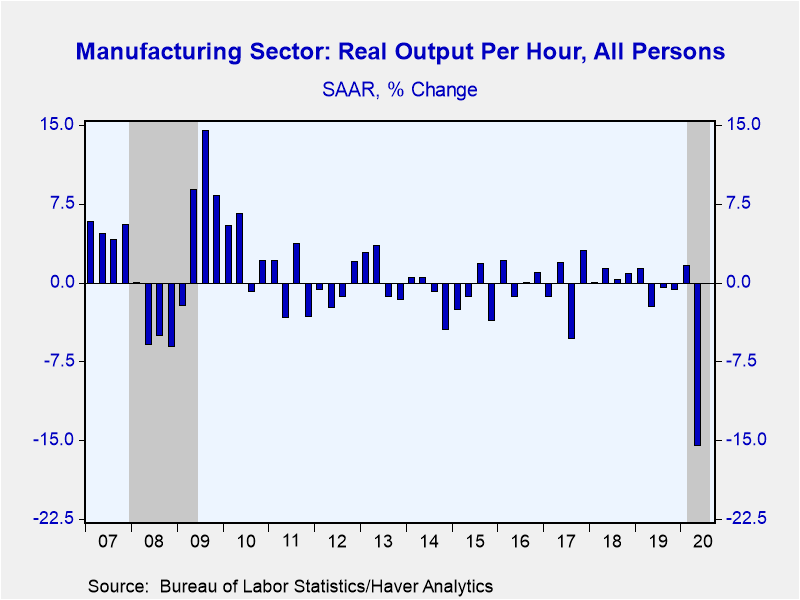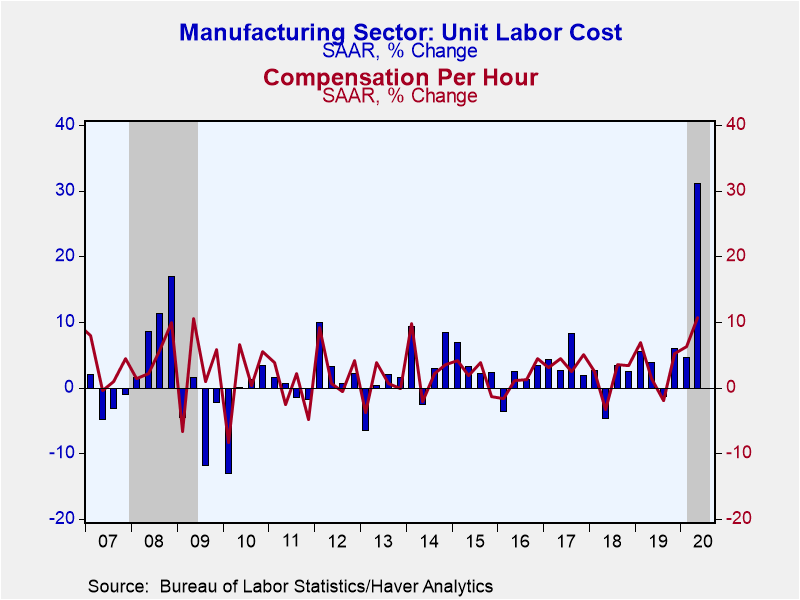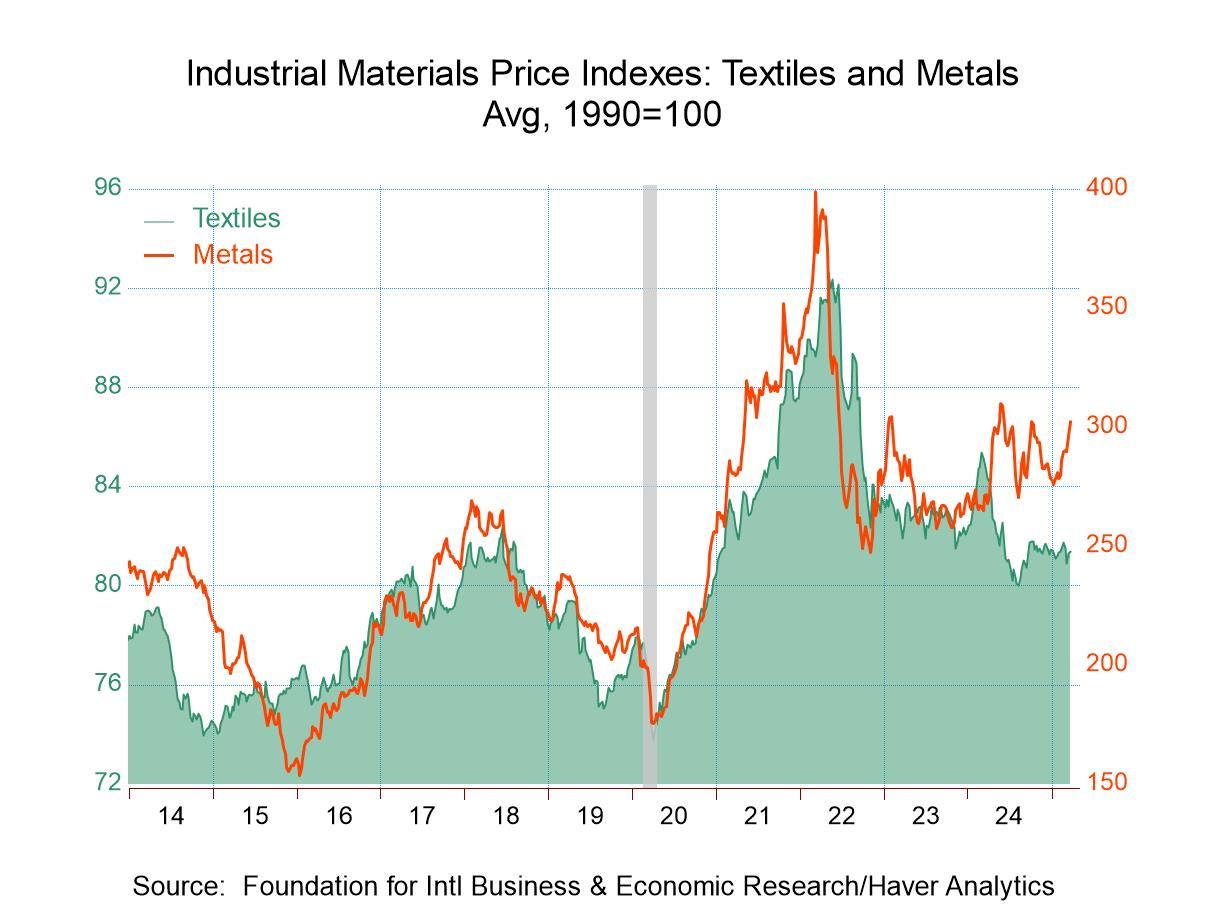 Global| Aug 14 2020
Global| Aug 14 2020U.S. Productivity Jumps in Q2 as Hours Fall More Than Output
Summary
• Productivity rose at a 7.3% annual rate in Q2; gains of this magnitude not uncommon during recessions. • Real output dropped at a 38.9% rate while hours collapsed 43.0%. • Revisions change pattern of growth, but on net small. [...]
• Productivity rose at a 7.3% annual rate in Q2; gains of this magnitude not uncommon during recessions.
• Real output dropped at a 38.9% rate while hours collapsed 43.0%.
• Revisions change pattern of growth, but on net small.
Productivity in the nonfarm business sector jumped at a greater-than-expected 7.3% seasonally adjusted annual rate (saar) during Q2'20 (2.2% year-on-year). This followed an upwardly-revised 0.3% decline in Q1'20 (was -0.9%). The Action Economics Forecast Survey expected just a 0.2% increase in Q2.
Productivity is measured as output per hour worked. So, while real output collapsed 38.9%, this was more than offset by the 43.0% annualized drop in hours worked. Hours fell from both cutbacks in employment (-41.0% saar) and weekly hours for those on the job (-3.4% saar). While the drivers of this productivity reading are unprecedented -- data goes back to 1947 -- productivity growth and volatility of this magnitude are not uncommon during recessions. Meanwhile revisions raised productivity growth in 2015, lowered it a bit in 2017 and 2019, and left the level of productivity 0.3% higher in Q1'20.
Compensation per hour and unit labor costs were buffeted by the same forces as productivity. A record 31.4% saar drop in compensation was more than offset by the 43.0% saar collapse in hours putting compensation per hour up at 20.4% rate. Dividing the jump in compensation by the rise in productivity resulted in a 12.2% gain in unit labor costs. Similar to productivity, while the drivers of unit labor costs experienced extraordinary moves, the growth in unit labor cost growth are not unique.
The manufacturing sector experienced the inverse of nonfarm business. Factory sector productivity fell at 15.5% rate last quarter (-4.1% y/y) with output dropping more (-47.0% saar) than hours (-37.3% saar). Since manufacturing is part of nonfarm business, this implies that non-manufacturing productivity growth was even stronger in Q2. Factory compensation per hour rose at a 10.7% pace pushing unit labor costs up at a 31.1% rate. In contrast to nonfarm business, the collapse in productivity and jump in unit labor costs were unprecedented.
The productivity and cost figures dating back to 1947 are available in Haver's USECON database. The expectations figures are from the Action Economics Forecast Survey and are found in the AS1REPNA database.
| Productivity & Costs (SAAR, %) | Q2'20 | Q1'20 | Q4'19 | Q1 Y/Y | 2019 | 2018 | 2017 |
|---|---|---|---|---|---|---|---|
| Nonfarm Business Sector | |||||||
| Output per Hour (Productivity) | 7.3 | -0.3 | 1.6 | 2.2 | 1.7 | 1.4 | 1.2 |
| Compensation per Hour | 20.4 | 9.4 | 3.3 | 8.0 | 3.6 | 3.4 | 3.5 |
| Unit Labor Costs | 12.2 | 9.8 | 1.7 | 5.7 | 1.9 | 1.9 | 2.2 |
| Manufacturing Sector | |||||||
| Output per Hour (Productivity) | -15.5 | 1.6 | -0.7 | -4.1 | 0.1 | 0.3 | -0.4 |
| Compensation per Hour | 10.7 | 6.2 | 5.2 | 5.0 | 2.9 | 2.1 | 3.2 |
| Unit Labor Costs | 31.1 | 4.6 | 6.0 | 9.4 | 2.8 | 1.8 | 3.6 |
Gerald D. Cohen
AuthorMore in Author Profile »Gerald Cohen provides strategic vision and leadership of the translational economic research and policy initiatives at the Kenan Institute of Private Enterprise.
He has worked in both the public and private sectors focusing on the intersection between financial markets and economic fundamentals. He was a Senior Economist at Haver Analytics from January 2019 to February 2021. During the Obama Administration Gerald was Deputy Assistant Secretary for Macroeconomic Analysis at the U.S. Department of Treasury where he helped formulate and evaluate the impact of policy proposals on the U.S. economy. Prior to Treasury, he co-managed a global macro fund at Ziff Brothers Investments.
Gerald holds a bachelor’s of science from the Massachusetts Institute of Technology and a Ph.D. in Economics from Harvard University and is a contributing author to 30-Second Money as well as a co-author of Political Cycles and the Macroeconomy.


